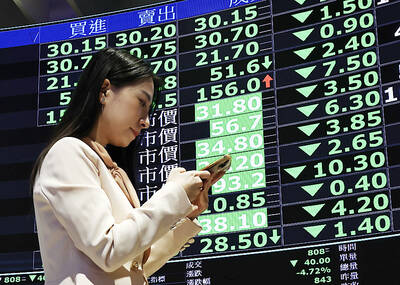Taiwan expects to add more than 1 gigawatt of renewable energy capacity this year, the Bureau of Energy said yesterday.
Three new offshore wind farms are slated for completion or partial operation this year, which would contribute more than 800 megawatts, while a major solar project on Taiwan Sugar Co’s (Taisugar, 台糖) land due to begin operations this year would account for 181 megawatts.
The COVID-19 crisis caused significant delays in renewable energy construction last year, Bureau of Energy section head Chen Chung-hsien (陳崇憲) said.
“Solar as well as offshore wind farms were affected,” Chen said. “With offshore wind farms, it was far more difficult to mobilize the construction boats due to the crisis.”
German energy group Wpd’s 640MW Yunlin offshore wind farm is slated to be partially completed this year, with more than 400MW to come online, Chen said. Meanwhile, Formosa 2 OWF off the shore of Miaoli, codeveloped by a Japanese-Australian-Taiwanese consortium, is due to be wholly developed, bringing 376MW of renewable energy capacity. Lastly, Taipower Power Co’s (Taipower, 台電) 110MW Changhua Wind Farm is scheduled to be completed this year. Currently, there is only one wind farm in operation, the 128 MW Formosa 1 off the coast of Miaoli.
The Ministry of Economic Affairs is expected to announce rules for “phase three” of the offshore wind farm development in the first quarter. Phase three is expected to release 10GW worth of projects between 2026 and 2035.
A solar farm with installed capacity of 181MW built on the state-owned Taisugar’s land on the salt fields of Tainan’s Cigu District (七股) is to begin operations later this year, as is a solar project incorporating aquaculture. There will be more joint aquaculture-solar projects to come after the 40MW pilot project in Chiayi, the energy bureau said.
After a controversial Council of Agriculture decision in July last year to limit solar farms on agricultural land and curb joint solar-agriculture projects, the Ministry of Economic Affairs has encouraged solar-aquaculture projects and multi-land-use solar farms to try to meet the government’s quota for total solar capacity, which was missed last year. The original goal for total solar capacity was 6.5GW by the end of last year, however, only 5.82 GW was reached. The goal for the end of this year will be 8.75GW.
By 2025, the Ministry of Economic Affairs aims to generate 20 percent of Taiwan’s energy through renewable means, including 20GW of solar and more than 5.7GW from offshore wind farms.

TARIFFS: The global ‘panic atmosphere remains strong,’ and foreign investors have continued to sell their holdings since the start of the year, the Ministry of Finance said The government yesterday authorized the activation of its NT$500 billion (US$15.15 billion) National Stabilization Fund (NSF) to prop up the local stock market after two days of sharp falls in reaction to US President Donald Trump’s new import tariffs. The Ministry of Finance said in a statement after the market close that the steering committee of the fund had been given the go-ahead to intervene in the market to bolster Taiwanese shares in a time of crisis. The fund has been authorized to use its assets “to carry out market stabilization tasks as appropriate to maintain the stability of Taiwan’s

STEEP DECLINE: Yesterday’s drop was the third-steepest in its history, the steepest being Monday’s drop in the wake of the tariff announcement on Wednesday last week Taiwanese stocks continued their heavy sell-off yesterday, as concerns over US tariffs and unwinding of leveraged bets weighed on the market. The benchmark TAIEX plunged 1,068.19 points, or 5.79 percent, to 17,391.76, notching the biggest drop among Asian peers as it hit a 15-month low. The decline came even after the government on late Tuesday authorized the NT$500 billion (US$15.2 billion) National Stabilization Fund (國安基金) to step in to buoy the market amid investors’ worries over tariffs imposed by US President Donald Trump. Yesterday’s decline was the third-steepest in its history, trailing only the declines of 2,065.87 points on Monday and

TAKING STOCK: A Taiwanese cookware firm in Vietnam urged customers to assess inventory or place orders early so shipments can reach the US while tariffs are paused Taiwanese businesses in Vietnam are exploring alternatives after the White House imposed a 46 percent import duty on Vietnamese goods, following US President Donald Trump’s announcement of “reciprocal” tariffs on the US’ trading partners. Lo Shih-liang (羅世良), chairman of Brico Industry Co (裕茂工業), a Taiwanese company that manufactures cast iron cookware and stove components in Vietnam, said that more than 40 percent of his business was tied to the US market, describing the constant US policy shifts as an emotional roller coaster. “I work during the day and stay up all night watching the news. I’ve been following US news until 3am

TARIFF CONCERNS: The chipmaker cited global uncertainty from US tariffs and a weakening economic outlook, but said its Singapore expansion remains on track Vanguard International Semiconductor Corp (世界先進), a foundry service provider specializing in producing power management and display driver chips, yesterday withdrew its full-year revenue projection of moderate growth for this year, as escalating US tariff tensions raised uncertainty and concern about a potential economic recession. The Hsinchu-based chipmaker in February said revenues this year would grow mildly from last year based on improving supply chain inventory levels and market demand. At the time, it also anticipated gradual quarter revenue growth. However, the US’ sweeping tariff policy has upended the industry’s supply chains and weakened economic prospects for the world economy, it said. “Now